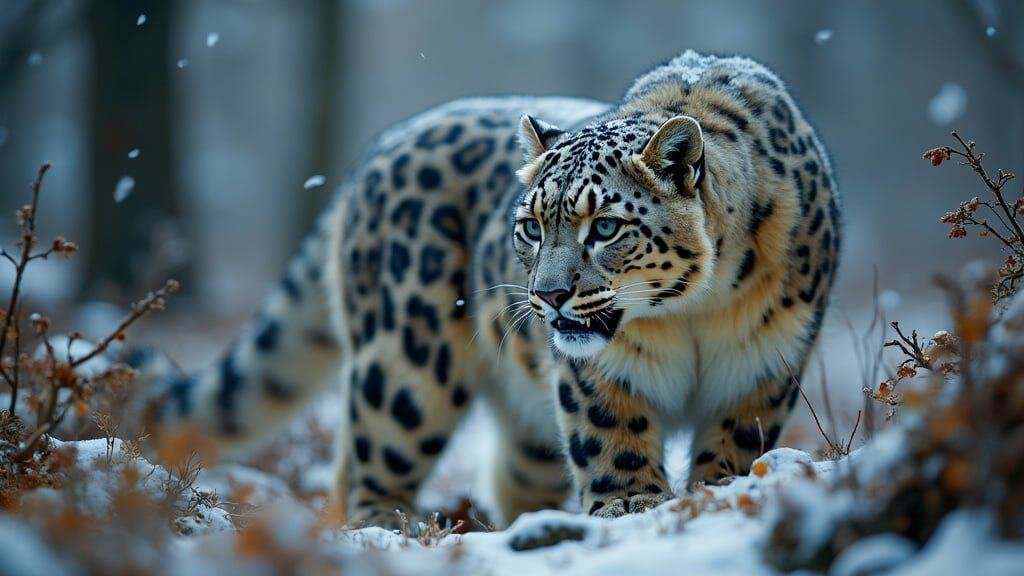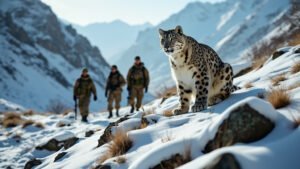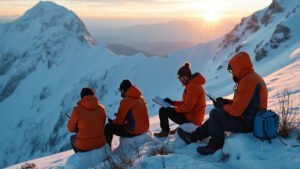Introduction
The Global Snow Leopard & Ecosystem Protection Program (GSLEP) is an international initiative dedicated to preserving the snow leopard, a species often referred to as the “ghost of the mountains,” and its vital ecosystem
Established in 2013, this program unites 12 snow leopard range countries to address the challenges faced by this endangered species. This article will explore the GSLEP’s history, objectives, and participating countries, along with its conservation strategies, achievements, and ongoing challenges
What Is The GSLEP Program?
The Global Snow Leopard & Ecosystem Protection Program (GSLEP) is a comprehensive international effort aimed at ensuring the survival of snow leopards and the preservation of the ecosystems they inhabit
Initiated in 2013, GSLEP brings together governments, conservationists, and local communities across the 12 snow leopard range countries. The program was born out of a growing recognition that the conservation of this elusive predator requires coordinated global action, given its habitat spans multiple nations and remote, rugged terrains
History and Background
The idea for the GSLEP was first conceived during the Global Snow Leopard Conservation Forum held in Bishkek, Kyrgyzstan, in October 2013. This historic meeting was attended by leaders and representatives from all 12 snow leopard range countries, as well as international organizations, scientists, and conservationists
The forum culminated in the adoption of the Bishkek Declaration, which laid the foundation for the GSLEP. The declaration recognized the urgent need to protect the snow leopard and its mountain ecosystems, which are under threat from habitat loss, poaching, climate change, and other human-induced pressures
The GSLEP was officially launched as part of this declaration, with a commitment to secure at least 20 snow leopard landscapes by 2020. These landscapes were identified based on their significance for the species’ survival, with a focus on maintaining viable and connected populations of snow leopards across their range
The program also emphasized the importance of involving local communities in conservation efforts, recognizing that their participation is crucial for the long-term success of the initiative
Core Objectives
The GSLEP has several core objectives, all centered around the overarching goal of ensuring the survival of snow leopards in the wild. These objectives include:
Conserving Key Snow Leopard Habitats: Protecting and managing landscapes that are critical for the long-term survival of snow leopards. This involves securing habitats from encroachment, maintaining connectivity between populations, and mitigating the impacts of climate change
Combating Poaching and Illegal Trade: Strengthening efforts to combat poaching and the illegal trade of snow leopards and their prey. This includes enhancing law enforcement, increasing the capacity of local authorities, and promoting community-based conservation initiatives
Promoting Sustainable Development: Integrating conservation with sustainable development to ensure that local communities benefit from the preservation of snow leopard habitats. This involves promoting eco-friendly livelihoods, reducing human-wildlife conflicts, and fostering a sense of stewardship among local populations
Fostering International Collaboration: Enhancing cooperation among the range countries and with international organizations to share knowledge, resources, and best practices. This includes facilitating cross-border conservation initiatives and supporting research on snow leopards and their ecosystems
Raising Awareness and Education: Increasing public awareness and understanding of the importance of snow leopard conservation. This includes educational programs, media campaigns, and outreach activities aimed at fostering a global commitment to the species’ protection
Key Stakeholders
The success of the GSLEP depends on the active participation and collaboration of a diverse range of stakeholders. These include:
National Governments: The governments of the 12 snow leopard range countries play a pivotal role in implementing the GSLEP. They are responsible for developing and enforcing policies, allocating resources, and coordinating conservation efforts at the national level
International Organizations: Organizations such as the World Wildlife Fund (WWF), the Snow Leopard Trust, and the United Nations Development Programme (UNDP) provide critical support to the GSLEP. They offer technical expertise, funding, and advocacy to help achieve the program’s goals
Local Communities: Local communities living within snow leopard habitats are integral to the success of the GSLEP. Their involvement in conservation activities, such as monitoring snow leopard populations, protecting habitats, and managing human-wildlife conflicts, is essential for the program’s long-term sustainability
Scientific and Research Institutions: Research institutions contribute valuable knowledge and data on snow leopards and their ecosystems. This information is crucial for informing conservation strategies, assessing the effectiveness of interventions, and adapting approaches to changing circumstances
Participating Countries In The GSLEP
The Global Snow Leopard & Ecosystem Protection Program (GSLEP) is a collaborative effort that spans 12 countries across Asia, all of which are home to the snow leopard. These range countries share the responsibility of preserving the species and the unique mountain ecosystems it inhabits
The countries involved have committed to coordinated actions under the GSLEP framework, recognizing that the conservation of snow leopards is a shared challenge that transcends national borders
Countries Involved
The 12 participating countries in the GSLEP are Afghanistan, Bhutan, China, India, Kazakhstan, Kyrgyzstan, Mongolia, Nepal, Pakistan, Russia, Tajikistan, and Uzbekistan
Each of these nations plays a crucial role in the program, as they collectively harbor the entirety of the snow leopard’s natural range. These countries have varied landscapes, from the towering peaks of the Himalayas to the vast steppes of Central Asia, all of which provide essential habitats for the snow leopard:
Afghanistan: The Hindu Kush mountains in Afghanistan provide a critical, though rugged and remote, habitat for snow leopards. Despite ongoing conflict, the country has committed to snow leopard conservation through the GSLEP
Bhutan: Bhutan’s pristine mountain environments are prime snow leopard territory. The country is renowned for its conservation ethos, with significant portions of its land designated as protected areas
China: As the country with the largest snow leopard population, China’s role in the GSLEP is particularly significant. The vast expanses of the Tibetan Plateau and surrounding mountain ranges are crucial for the species’ survival
India: The Indian Himalayas, including regions like Ladakh and Himachal Pradesh, are key snow leopard habitats. India’s involvement in the GSLEP includes efforts to reduce human-wildlife conflict and promote eco-tourism
Kazakhstan: Kazakhstan’s Altai and Tien Shan mountains are important habitats for snow leopards. The country has been active in regional conservation initiatives under the GSLEP
Kyrgyzstan: As the birthplace of the GSLEP, Kyrgyzstan has been a leader in snow leopard conservation. The country’s mountains, particularly the Tien Shan, are vital to the species’ survival
Mongolia: Mongolia’s Altai Mountains are home to a significant population of snow leopards. The country has been proactive in monitoring and protecting these cats as part of its GSLEP commitments
Nepal: The high-altitude regions of Nepal, including the Annapurna and Everest areas, are strongholds for snow leopards. Nepal has integrated snow leopard conservation into its broader environmental policies
Pakistan: Pakistan’s Karakoram and Hindu Kush ranges are critical snow leopard habitats. The country is engaged in several community-based conservation projects under the GSLEP
Russia: Russia’s snow leopards are primarily found in the Altai and Sayan Mountains. The country has focused on habitat protection and anti-poaching measures within the GSLEP framework
Tajikistan: Tajikistan’s Pamir Mountains are a key region for snow leopards. The country has implemented several conservation initiatives, including transboundary cooperation with neighboring countries
Uzbekistan: Uzbekistan’s snow leopards inhabit the Tien Shan and Pamir-Alay mountains. The country has been working on habitat conservation and anti-poaching efforts as part of the GSLEP
National Commitments
Each of the participating countries has made specific national commitments under the GSLEP, tailored to their unique ecological and socio-political contexts. These commitments often include the establishment of protected areas, the implementation of national snow leopard action plans, and the integration of snow leopard conservation into broader environmental and development policies
For example, Bhutan has committed to protecting more than 50% of its snow leopard habitats through its extensive network of national parks and wildlife sanctuaries
China has focused on scientific research, investing in camera traps and satellite collars to better understand snow leopard behavior and population dynamics. India has launched the “Project Snow Leopard,” which aims to safeguard the species through community participation and landscape-level conservation approaches
Regional Collaboration
One of the key strengths of the GSLEP is its emphasis on regional collaboration. Snow leopards roam across vast and often transboundary landscapes, making it essential for neighboring countries to work together
The GSLEP facilitates this through joint initiatives such as the “Transboundary Landscapes” program, which promotes coordinated conservation efforts across borders. For instance, Kazakhstan, Kyrgyzstan, and Tajikistan collaborate on protecting the snow leopards of the Tien Shan range, focusing on habitat connectivity and anti-poaching strategies
These regional efforts are supported by international organizations, which help to bridge gaps between national policies and facilitate the sharing of best practices. The GSLEP also organizes regular meetings and workshops, where representatives from the range countries can discuss progress, challenges, and future strategies
Conservation Strategies Of The GSLEP
The Global Snow Leopard & Ecosystem Protection Program (GSLEP) employs a multifaceted approach to conserve snow leopards and the ecosystems they inhabit
These strategies are designed to address the complex challenges faced by snow leopards, which range from habitat loss and poaching to climate change and human-wildlife conflict. By implementing a combination of habitat protection, anti-poaching efforts, and community engagement, the GSLEP aims to create a sustainable future for snow leopards across their range
Habitat Protection Initiatives
One of the core strategies of the GSLEP is to protect and restore the habitats that are crucial for the survival of snow leopards. This involves not only safeguarding existing habitats but also ensuring that these areas remain connected, allowing snow leopards to roam freely and maintain genetic diversity
To achieve this, the GSLEP has identified and prioritized key landscapes known as “Priority Landscapes” across the snow leopard range. These landscapes are selected based on their ecological importance and their potential to support viable snow leopard populations
The program aims to secure at least 20 of these landscapes, ensuring that they are effectively managed and protected from threats such as habitat fragmentation, infrastructure development, and climate change
For instance, the Altai-Sayan region, which spans parts of Russia, Mongolia, and Kazakhstan, is one of these Priority Landscapes. Efforts in this area include the creation of protected areas, restoration of degraded habitats, and the promotion of sustainable land-use practices. Similar initiatives are underway in other key regions, such as the Himalayas and the Tien Shan Mountains
Anti-Poaching Efforts
Poaching and illegal trade pose significant threats to snow leopards, as well as to their prey species, which include blue sheep and ibex. The GSLEP has implemented robust anti-poaching strategies to combat these threats, focusing on both enforcement and community involvement
One of the key components of this strategy is the establishment of specialized anti-poaching units. These units are trained to patrol snow leopard habitats, monitor poaching activities, and apprehend poachers. In Mongolia, for example, the GSLEP has supported the creation of ranger teams that work closely with local communities to gather intelligence and prevent illegal hunting
Additionally, the GSLEP has invested in improving legal frameworks and strengthening penalties for wildlife crimes. This includes working with governments to ensure that poaching and illegal trade are treated as serious offenses and that law enforcement agencies have the resources they need to tackle these issues effectively
Community-based anti-poaching initiatives are also a crucial part of the GSLEP’s strategy. By involving local communities in conservation, the program seeks to reduce the incentives for poaching and promote alternative livelihoods. In Nepal, for example, community-led anti-poaching groups have been established in snow leopard habitats, where local residents take an active role in protecting wildlife
Community Engagement Programs
Engaging local communities is essential for the success of snow leopard conservation efforts. The GSLEP recognizes that the people living in and around snow leopard habitats are key stakeholders whose support is vital for the long-term sustainability of conservation initiatives
The GSLEP’s community engagement programs are designed to address the socio-economic challenges that can drive human-wildlife conflict and poaching. These programs focus on creating incentives for conservation, such as providing alternative livelihoods, improving livestock management practices, and promoting eco-tourism
In India, for example, the GSLEP has supported initiatives that help herders adopt predator-friendly livestock management techniques, such as building predator-proof corrals and using guard dogs. These measures have significantly reduced livestock losses to snow leopards, which in turn has helped to reduce retaliatory killings of these big cats
Eco-tourism is another important aspect of the GSLEP’s community engagement strategy. By promoting snow leopard-based tourism, the program aims to create economic opportunities for local communities while raising awareness about the importance of conservation
In Bhutan, community-managed eco-tourism initiatives have been developed in snow leopard habitats, offering tourists the chance to experience the country’s rich biodiversity while contributing to conservation efforts
Furthermore, the GSLEP places a strong emphasis on education and capacity building. This includes training programs for local communities on wildlife monitoring, sustainable land use, and conflict resolution. In Pakistan, for example, community members have been trained as “citizen scientists,” enabling them to participate in snow leopard research and conservation activities
These community engagement efforts are complemented by broader awareness-raising campaigns that aim to change attitudes towards snow leopards and promote a culture of conservation. Through education, outreach, and the involvement of local communities, the GSLEP is working to create a sustainable coexistence between people and snow leopards across the species’ range
Achievements And Challenges Of The GSLEP
Since its inception in 2013, the Global Snow Leopard & Ecosystem Protection Program (GSLEP) has made significant strides in conserving snow leopards and their habitats. However, the program has also faced various challenges that continue to impact its efforts
This section explores the notable successes achieved by the GSLEP, the ongoing challenges it encounters, and its future goals
Notable Successes
The GSLEP has achieved several important milestones that demonstrate the effectiveness of its conservation strategies. One of the most significant achievements is the successful establishment of Priority Landscapes across the snow leopard range
These landscapes have become focal points for conservation efforts, with targeted actions being implemented to protect snow leopard habitats, reduce poaching, and engage local communities
For instance, in Mongolia, the GSLEP has been instrumental in expanding protected areas within the Altai-Sayan region, a critical snow leopard habitat. This expansion has provided increased security for snow leopards and their prey, while also promoting sustainable land use practices among local communities
Another notable success is the enhancement of scientific research and monitoring across the snow leopard range. The GSLEP has facilitated the deployment of advanced technologies such as camera traps and GPS collars, which have greatly improved our understanding of snow leopard behavior, population dynamics, and habitat use
In India, for example, camera trap surveys supported by the GSLEP have provided valuable data on snow leopard populations in the Himalayas, helping to inform conservation strategies
The GSLEP has also made significant progress in international collaboration, bringing together the 12 range countries to work collectively on snow leopard conservation
This cooperation has led to the development of joint initiatives, such as transboundary conservation projects and cross-border anti-poaching efforts. The Kyrgyzstan-Tajikistan-China transboundary landscape, for example, is a model of how countries can collaborate to protect shared snow leopard populations
Ongoing Challenges
Despite these successes, the GSLEP faces a number of ongoing challenges that complicate its conservation efforts. One of the most pressing challenges is habitat fragmentation and degradation
Rapid infrastructure development, such as roads and mining, continues to encroach on snow leopard habitats, disrupting migration patterns and isolating populations. In China, for instance, expanding road networks in the Tibetan Plateau have posed significant risks to snow leopard habitats, highlighting the need for more stringent environmental impact assessments and mitigation measures
Human-wildlife conflict remains another major challenge for the GSLEP. In many snow leopard habitats, local communities rely on livestock for their livelihoods, leading to conflicts when snow leopards prey on domestic animals
Although the GSLEP has implemented various measures to reduce these conflicts, such as predator-proof corrals and compensation schemes, incidents of retaliatory killings still occur. This is particularly challenging in regions like Pakistan’s Karakoram range, where high livestock losses continue to fuel negative attitudes toward snow leopards
Poaching and illegal trade also persist as significant threats to snow leopards. The demand for snow leopard pelts and bones in illegal markets drives poaching across the species’ range. Despite increased enforcement efforts, weak legal frameworks and insufficient resources for law enforcement remain barriers to effectively combating poaching
In Afghanistan, for example, ongoing conflict and lack of infrastructure make it difficult to control poaching activities in remote snow leopard habitats
Additionally, climate change poses a long-term threat to snow leopards and their ecosystems. Rising temperatures and changing precipitation patterns are altering the landscapes that snow leopards depend on, potentially pushing them to higher altitudes and reducing prey availability
In Nepal, climate change impacts have been observed in the form of shrinking glaciers and shifting vegetation zones, which may ultimately affect snow leopard distribution
Future Goals
Looking ahead, the GSLEP has set ambitious goals to address these challenges and continue its conservation efforts. One of the key goals is to expand and strengthen the network of Priority Landscapes across the snow leopard range
This includes identifying new areas for protection, improving the management of existing landscapes, and ensuring connectivity between habitats. The GSLEP aims to secure at least 30 such landscapes by 2030, with a focus on regions that are currently underrepresented in conservation efforts
The GSLEP also plans to enhance its community engagement programs, recognizing that the involvement of local communities is crucial for the long-term success of snow leopard conservation. Future initiatives will focus on increasing the benefits of conservation for local residents, such as through expanded eco-tourism opportunities and more effective livestock protection measures
In Bhutan, for example, the GSLEP is exploring new ways to integrate snow leopard conservation with community-based tourism, providing economic incentives for protecting wildlife
To tackle the ongoing threat of poaching, the GSLEP aims to strengthen anti-poaching networks and improve cross-border cooperation. This includes enhancing intelligence-sharing between range countries, improving the capacity of law enforcement agencies, and increasing the penalties for wildlife crimes
In Kazakhstan, the GSLEP is working with local authorities to develop more effective anti-poaching strategies, including the use of technology such as drones for surveillance
Finally, the GSLEP is committed to addressing the impacts of climate change on snow leopards and their habitats. This involves conducting research to better understand how climate change is affecting snow leopard ecosystems and developing adaptive management strategies
In Tajikistan, for example, the GSLEP is supporting studies on how changing weather patterns are influencing snow leopard prey availability, with the aim of developing targeted conservation interventions
Conclusion
The Global Snow Leopard & Ecosystem Protection Program (GSLEP) represents a vital international effort to conserve one of the world’s most elusive big cats and the fragile mountain ecosystems they inhabit
Since its launch in 2013, the GSLEP has made significant progress through habitat protection, anti-poaching initiatives, and community engagement across the 12 participating countries. Notable achievements include the establishment of Priority Landscapes and advancements in scientific research, which have provided valuable insights into snow leopard populations
However, challenges such as habitat fragmentation, human-wildlife conflict, poaching, and the looming threat of climate change continue to hinder conservation efforts
Moving forward, the GSLEP is focused on expanding its conservation reach, strengthening community involvement, and enhancing cross-border cooperation to secure a sustainable future for snow leopards. By addressing these challenges, the GSLEP aims to ensure that snow leopards continue to thrive in the wild, preserving both the species and the ecosystems upon which they depend











